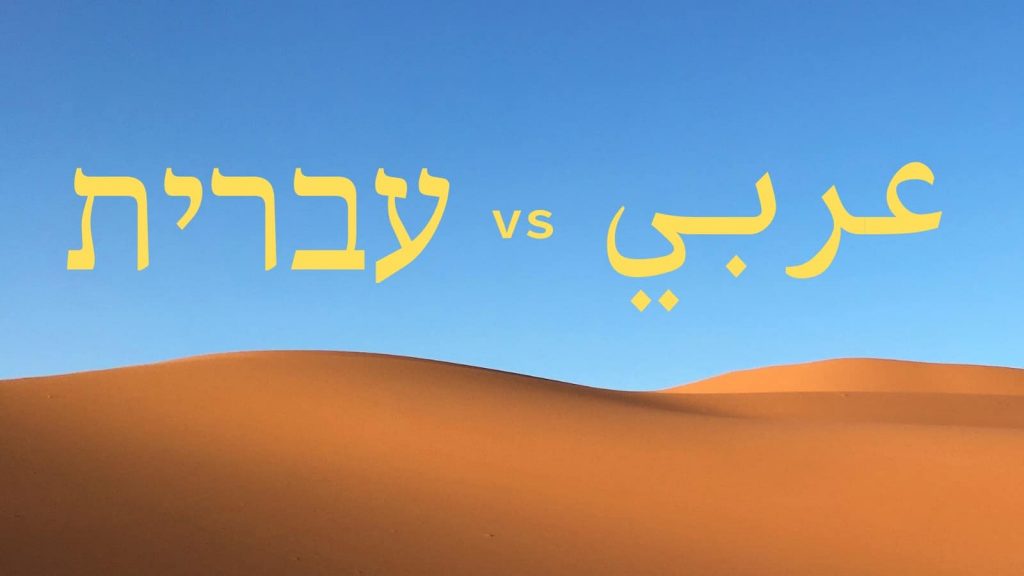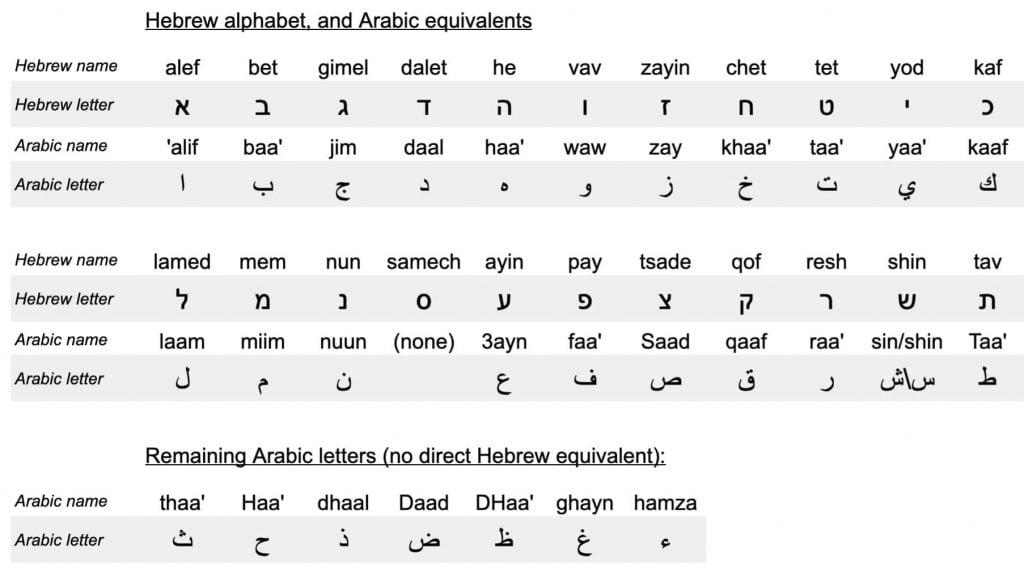Hebrew and Spoken Arabic — How Similar Are They?
Hebrew and spoken Arabic are not as similar as you might think.
Many think they are quite similar, being both of Semitic origin and sharing a lot of common concepts.
There are definitely many similarities between Hebrew and spoken Arabic. There are shared words (and words that just sound similar, like the numbers), some common grammatical concepts, alphabets that look reminiscent, and similar vocalisations (a tendency to say “kh”).
But as someone who knows decent spoken Arabic and who has a solid foundation in Hebrew, I can tell you from personal experience with both that spoken Arabic and spoken Hebrew are quite different.
Read on to find out more.

Contents
Why think Hebrew and Arabic are similar?
It’s tempting to think Arabic and Hebrew are similar because they’re related.
They are, after all from the same language family — Semitic languages — and have evolved in an overlapping region of the world.
The Semitic language group is quite small. In fact, it’s mostly dominated by Arabic, both Modern Standard Arabic and all the local versions of Arabic (see our guide to the dialects of Arabic here). And in the Semitic language group, Amharic (Ethiopia’s official language, though not their most widely-spoken language) is spoken by many more people than Hebrew.
Europeans and English speakers are familiar with the concept of language families.
You might be familiar with Romance languages, like French and Spanish, and know that they have a lot in common: similar conjugation patterns, sentence order, vocabulary and concepts like gender. But nonetheless, someone who speaks French definitely cannot understand Spanish, nor vice versa.
Or you might know Germanic languages, like German and Dutch (or Yiddish). You’d know that again, they have the same things in common. These can be even closer. German and Yiddish are actually often mutually intelligible, if you squint your ears.
But Arabic and Hebrew are definitely NOT mutually intelligible. In fact, they might be about as similar as German and English.
You might also like…
- The differences and similarities between Persian and Arabic
- An overview of the Arabic dialects
- An introduction to Egyptian Arabic survival expressions
Similarities between Hebrew and Spoken Arabic

We speak spoken Egyptian Arabic. While the many dialects of Arabic are distinct, Egyptian Arabic is the most widely spoken. Also, its grammar is about identical in complexity to nearly all other spoken Arabic dialects.
For example, the spoken grammar in Egyptian Arabic is very similar to that in Palestinian Arabic, spoken throughout Israel and the occupied Palestinian territories (mostly the West Bank/Gaza). I have a good understanding of Levantine Arabic so the same similarities exist.
Let’s start with the similarities between spoken Hebrew and spoken Arabic:
- They’re both Semitic languages. This is a fairly exclusive club shared only with a few Ethiopian languages and Aramaic, as well as of course all the dialects of Arabic and Modern Standard Arabic.
- Both Hebrew and Arabic rely on systems of three-letter roots. Groups of three letters (“triliteral roots”) are the foundations of form verbs and nouns. This means you’ll see the same groups of letters in clusters of words with related meanings. A specific example: you can find the same cluster of letters (in both languages) in words related to writing (the verb), authors, books, offices and libraries.
- Some conjugation patterns overlap between Hebrew and Arabic. The past and future tense in Hebrew and Arabic quite similar. But the present tense is quite different.
- Hebrew and Arabic share some letters of the alphabet. Some of the letters look similar, or have similar names. like ש (sin) and س (also sin), and some have the same names, like ا (alef) and א (also alef).
- Some Hebrew and Arabic words are the same. At the beginner/intermediate level, the words for “night”, “four”, “house” and “date” are the same. Note that these are pronounced slightly differently.
- Both Hebrew and Arabic don’t write their vowels (in everyday, non-religious language). This makes it hard for the initial learner, as you have to memorise where the vowels should go, learning the patterns of words.
- Both Hebrew and Arabic have a “classical” form. This is much more formal than spoken Hebrew and Arabic (and more formal than Modern Standard Arabic too). The classical form writes in all the vowels and is used in mostly religious circumstances.
- Both Hebrew and Arabic are written right to left.
- There’s shared slang between Hebrew and Arabic. Mabsuut, akhi.
For the Arabic speaker learning Hebrew, or the Hebrew speaker learning Arabic, there are a few things that make it easy to make the jump.
- Sentence structure, including possession/ownership. Both Arabic and Hebrew use the “the” particle to express ownership and make basic phrases in similar ways. For example, neither Hebrew nor Arabic has an “is” equivalent, though they have it for past and future tense. For example, to express “the house is big”, in either language you just say “the-house big”. Similarly, to say “the big house” you say “the-house the-big”.
- A common concept of triliteral roots. Both Hebrew and Arabic speakers will be familiar will making many words out of the same group of letters. Just like how in Arabic many words related to writing (like desk, office, and book) come from the letters “k-t-b”(كتب), in Hebrew similar words come from the root letters “k-t-v” (כתב).
- Many words sound similar. There’s very little shared vocabulary. But the words will remind you of words in the other language.
For example, see the words below for a semi-random snapshot of similar words between Arabic and Hebrew:
| English | Hebrew | Arabic |
|---|---|---|
| stomach/belly | بطن (baTn) | בטן (beten) |
| fresh | طري (Tari) | טרי (tari) |
| minute, hour | דקה, שעה (daka, sha’a) | دقيقة ، ساعة (da’ii’a, saa3a) |
| apple, watermelon, olive | תפוח, אבטיח, זית (tapuach, avatiach, zayt) | تفاح، بطيخ، زيتون (tofaaH, baTTiikh, zaytun) |
| on, beneath, after | על, מתחת, אחרי () | على ، تحت ، اخر (ala, taHt, aakhir) |
| I, you, they | אני, אתה, הם (ani, ata, hem) | أنا ، أنت ، هم (ana, inta, hem) |
| left, right | שמאל, ימין (smol, yamin) | يسار يمين (basaar, yamiin) |
| 1, 2, 3 | אחת שתיים שלוש (echat, shteym, shalosh) | واحد, اثنين, ثلاثة (waaHid, itnayn, talaata) |
| house | בית (bait) | بيت (bayt) |
| how many? where? who? | כמה? איפה? אן ? מי? (kama? eyfo? an*? mi?) | كم؟ وين؟ من؟ (kam? wayn? min?) |
* Used as part of phrases like “where are you going?”
So far, so good, right? Unfortunately, these words are the minority. Beyond these superficial elements, the differences are large.
Differences between Hebrew and Arabic (spoken)
Despite the similarities, the differences between Arabic and Hebrew are significant.
- Hebrew and Arabic first-person conjugation is quite different. Spoken Hebrew uses four first-person conjugations, modifying for genders and plurals only, whereas spoken Arabic modifies for person as well and does gender a bit differently.
- Plurals are much more complicated in Arabic than Hebrew. Almost all have to be learned individually. In Hebrew, they are mostly predictable.
- Arabic is harder to pronounce than Hebrew. It has preserved more guttural sounds in colloquial pronunciation. Arabic varies by region, but in general, it’s harder. Hebrew used to have guttural pronunciation, but it was simplified when Hebrew was revived.
- Spoken Arabic is very distinct from written Arabic, whereas spoken and written Hebrew are very similar. Spoken Arabic is not formally governed and is also more blended with other languages. For a cocktail of reasons, spoken Arabic is usually described as a “dialect” or “slang”, with no formal written structure (despite existing written in the wild). This means you’ll often hear French, English and Turkish words in Egyptian Arabic, not to mention words borrowed from Arabic dialects in other regions, like Morocco or the nearby countries of the Levant. Hebrew is much more written like it’s spoken and vice versa, and governed by an organisation that regulates language and new words; nowhere near as flexible as is spoken Arabic.
- Egyptian/Levantine Arabic mashes together prepositions and negations into longer words. For example, “I haven’t seen it” becomes basically one word “mashuftuush“. Hebrew is much easier to parse, with an equivalent phrase being “lo ra’iti oto“.
In fact, the differences are so large that I think that a Farsi speaker has more of an advantage in Arabic than a Hebrew speaker, even though Farsi and Arabic are totally different language families. At least they share a script and some vocabulary.
In summary, if you speak Hebrew or Arabic, you have maybe a conceptual head-start to learning the other. You’d be coming from a closer place than a Chinese native speaker, for example. But you’re still far away.







Nice article, but a bit high level analysis.
According to what I know, there are more similarities than the ones you have mentioned.
On a second note, the Arabic language is a one unified language and it is the one we study & read with, yet the local slang versions are only for speaking ( you can speak the official one anytime you want and you will be immediately
understood across Arabic speakers even if they were illiterate) which is the case since ever, so local slangs would vanish and change with time but Arabic stays the same.
Yes, definitely high level. This is a comparison of the spoken dialects, from the perspective of a learner.
תפוח is an apple, not a strawberry. Strawberr is תות. Just a heads up. שלים.
Ah, thank you! I missed that change between versions, because “תות” is also similar to “توت” (another berry word). But apple seemed like a better example.
The aim and objective is to cause confusion. Eloi/Eloh/Alaah/Allah/Al-Lah/Alah Aramaic/Hebrew/Arabic
Seemingly the aim of all languages…
Good article. It gave me the information that I needed.
only mistake is that Tet and Tav equivalent in arabic are inversed the one you placed the one placed for Tet goes for Tav and the one for Tav to tet, the examples you’ve given shown it actually
Nice Article. Bot… i wil explain you something. some Hebrew alphabet, in traditional hebrew, has 2 vocals. like ד or דּ, that is not used in modern hebrew. that’s why you didn’t found all Arabic alphabet in Hebrew. Bot thay exist.
2. Arabic is more similer to Aramaic then to Hebrew.
3.Also thare diference in pronunciation by origen, like ג is pronunced (english) G or J. in case we have a word need to bee pronunced J, Usualy now we putting ג’ to knoew is a J, because most peaple pronuncing it G.
(in case we have a word coming from origen who use ג and גּ, and it dont have vowels, so as most of the peaple don´t use to it, so thay will not know its a J, – the yemen use غimel and Jimel. See more https://en.wikipedia.org/wiki/Yemenite_Hebrew)
Germans and the British are very related and most Brits actually have German blood. Anglo Saxons are a Germanic people.
That’s historically interesting, but it’s not relevant to a comparison of modern languages. The Anglo-Saxons were in Britain over a thousand years ago. Modern British people come from all over the world — Europe, Africa, and all of Asia (both East Asia and the subcontinent).
The last paragraph, as a Chinese native speaker who is contemplating to learn one of the two languages, is not so encouraging to read 😉
Haha. I more meant if you are using Chinese as a foundation to learn Arabic or Hebrew you’d have a challenge, considering the dissimilarity! Without knowing your background (perhaps you live in an English-speaking country, or perhaps you are like one of the many highly educated Chinese people I met), it sounds like you are fluent in English. And also you probably have a better understanding of learning languages than most, being at least bilingual. Good luck, work hard, 加油,活到老,学到老!
Dana Hooshmand is really really bright. Man o Man…I love the depth and detail. I could just read each one of his analytics. This said, I would also appreciate learning about the ancient history of these languages and what preceded them. Example: Was Home ever exposed to Sanskrit or Vedic languages?
That’s really kind of you. But I’m not well-versed in ancient Hebrew and classical Arabic. There are scholars who go into much greater detail than I do, and dedicate their lives to this work, but that’s beyond my domain, which is mostly related to intercultural communication.